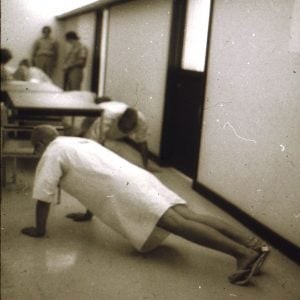Zimbardo and his colleagues (1973) were interested in finding out whether the brutality reported among guards in American prisons was due to the sadistic personalities of the guards (i.e., dispositional) or had more to do with the prison environment (i.e., situational).
Do guards have to behave sometimes aggressively, because they are dealing with people who don’t respect any law? Do guards enjoy inflicting pain on prisoners?
Zimbardo believed the situation made people act the way they do and that’s more important than disposition (personality). Zimbardo (1973) had intended that the experiment should run for two weeks, but on the sixth day, it was terminated, due to the emotional breakdowns of prisoners, and excessive aggression of the guards.
Zimbardo converted a basement of the Stanford University psychology building into a Mock prison. He advertised asking for volunteers to participate in a study of the psychological effects of prison life.
The 75 applicants who answered the ad were given diagnostic interviews and personality tests to eliminate candidates with psychological problems, medical disabilities, or a history of crime or drug abuse.
24 men judged to be the most physically & mentally stable, the most mature, and the least involved in antisocial behaviors were chosen to participate. The participants did not know each other prior to the study and were paid $15 per day to take part in the experiment.
Participants were randomly assigned to either the role of prisoner or guard in a simulated prison environment. There were two reserves, and one dropped out, finally leaving ten prisoners and 11 guards.
Prisoners were treated like every other criminal, being arrested at their own homes, without warning, and taken to the local police station. They were fingerprinted, photographed and ‘booked.’
Then they were blindfolded and driven to the psychology department of Stanford University, where Zimbardo had had the basement set out as a prison, with barred doors and windows, bare walls and small cells.

When the prisoners arrived at the prison they were stripped naked, deloused, had all their personal possessions removed and locked away, and were given prison clothes and bedding. They were issued a uniform, and referred to by their number only. The use of ID numbers was a way to make prisoners feel anonymous. Each prisoner had to be called only by his ID number and could only refer to himself and the other prisoners by number. This is a deindividuation.
They didn’t have underclothes, just uniforms and their number written on uniforms. They also had a tight nylon cap to cover their hair, and a locked chain around one ankle.
Guards were dressed in identical uniforms. They carried a whistle around their neck and billy clubs. Guards also wore special sunglasses to make eye contact with prisoners impossible. In my opinion, by preventing eye contact among two divided, even antagonistic groups with strict rules, you are preventing them to develop a human contact.
Three guards worked shifts of eight hours each (the other guards remained on call). Guards were instructed to do whatever they thought was necessary to maintain law and order in the prison and to command the respect of the prisoners. No physical violence was permitted.
Zimbardo observed the behavior of the prisoners and guards (as a researcher), and also acted as a prison warden.
Guards adopted their role easily and quickly and within a very short time prisoners were settling into their roles too.

At 2:30 a.m., just several hours later, some guards began to harass prisoners. Prisoners were awakened from sleep by blasting whistles for the first of many ‘’counts’’. The counts served as a way to familiarize the prisoners with their number. I wonder why Zimbardo did react not then? There was obvious that some ‘guards’ on the pretext of joking, in best case, were exhibiting proclivity for violence and were very aware of ‘power.’ It’s not in hindsight, but the fact that they had already forgot that they were paid participants in the experiment and not in some game. Either they weren’t mature as tests had shown or they had traits which were not for that experiment. Did Zimbardo adopt his role so fast or he didn’t observe them as a psychologist should have observed. More importantly, they provided a regular occasion for the guards to exercise control over the prisoners.

The prisoners soon adopted prisoner-like behavior too. They talked about prison issues a great deal of the time. They ‘told tales’ on each other to the guards.
They started taking the prison rules very seriously, as though they were there for the prisoners’ benefit and infringement would spell disaster for all of them. Some even began siding with the guards against prisoners who did not obey the rules.
The prisoners were taunted with insults and petty orders, they were given pointless and boring tasks to accomplish, and they were generally dehumanized.
Push-ups were a common form of physical punishment imposed by the guards. One of the guards stepped on the prisoners’ backs while they did push-ups, or made other prisoners sit on the backs of fellow prisoners doing their push-ups.

The guards were surprised and totally unprepared for the rebellion which broke out on the morning of the second day. During the second day of the experiment, the prisoners removed their stocking caps, ripped off their numbers, and barricaded themselves inside the cells by putting their beds against the door.
The guards called in reinforcements. The three guards who were waiting on stand-by duty came in and the night shift guards voluntarily remained on duty.
The guards retaliated by using a fire extinguisher which shot a stream of skin-chilling carbon dioxide, and they forced the prisoners away from the doors. Next, the guards broke into each cell, stripped the prisoners naked and took the beds out.
The ringleaders of the prisoner rebellion were placed into solitary confinement. After this, the guards generally began to intimidate the prisoners.
One of the three cells was designated as a “privilege cell.” The three prisoners the least involved in the rebellion were given special privileges. The guards gave them back their uniforms and beds and allowed them to wash their hair and brush their teeth.
Privileged prisoners also got to eat special food in the presence of the other prisoners who had temporarily lost the privilege of eating. The effect was to break the solidarity among prisoners.
As the prisoners became more dependent, the guards became more derisive towards them. They held the prisoners in contempt and let the prisoners know it. As the guards’ contempt for them grew, the prisoners became more submissive.
They demanded even greater obedience from the prisoners. The prisoners were dependent on the guards for everything, so tried to find ways to please the guards, such as telling tales on fellow prisoners.
Prisoner #8612
Less than 36 hours into the experiment, Prisoner #8612 began suffering from acute emotional disturbance, disorganized thinking, uncontrollable crying, and rage.
After a meeting with the guards where they told him he was weak, but offered him “informant” status, #8612 returned to the other prisoners and said “You can’t leave. You can’t quit.” Soon #8612 “began to act ‘crazy,’ to scream, to curse, to go into a rage that seemed out of control.” It wasn’t until this point that the psychologists realized they had to let him out.
A Visit from Parents
The next day, the guards held a visiting hour for parents and friends. They were worried that when the parents saw the state of the jail, they might insist on taking their sons home. Guards washed the prisoners, had them clean and polish their cells, fed them a big dinner and played music on the intercom.
After the visit, rumors spread of a mass escape plan. Afraid that they would lose the prisoners, the guards and experimenters tried to enlist help and facilities of the Palo Alto police department. The guards again escalated the level of harassment, forcing them to do menial, repetitive work such as cleaning toilets with their bare hands.
Catholic Priest
Zimbardo invited a Catholic priest who had been a prison chaplain to evaluate how realistic their prison situation was. Half of the prisoners introduced themselves by their number rather than name.
The chaplain interviewed each prisoner individually. The priest told them the only way they would get out was with the help of a lawyer.
Prisoner #819
Eventually, while talking to the priest, #819 broke down and began to cry hysterically, just like two previously released prisoners had.
The psychologists removed the chain from his foot, the cap off his head, and told him to go and rest in a room that was adjacent to the prison yard. They told him they would get him some food and then take him to see a doctor.
While this was going on, one of the guards lined up the other prisoners and had them chant aloud: “Prisoner #819 is a bad prisoner. Because of what Prisoner #819 did, my cell is a mess, Mr. Correctional Officer.”
The psychologists realized #819 could hear the chanting and went back into the room where they found him sobbing uncontrollably. The psychologists tried to get him to agree to leave the experiment, but he said he could not leave because the others had labeled him a bad prisoner.
At that point, Zimbardo said, “Listen, you are not #819. You are [his name], and my name is Dr. Zimbardo. I am a psychologist, not a prison superintendent, and this is not a real prison. This is just an experiment, and those are students, not prisoners, just like you. Let’s go.” He stopped crying suddenly, looked up and replied, “Okay, let’s go “as if nothing had been wrong.
Out of 50 or more outsiders who had seen the prison, Christina Maslach, a Stanford Ph.D. was the only one who ever questioned its morality.
Zimbardo (2008) later noted, “It wasn’t until much later that I realized how far into my prison role I was at that point — that I was thinking like a prison superintendent rather than a research psychologist. “
This led him to prioritize maintaining the experiment’s structure over the well-being and ethics involved, thereby highlighting the blurring of roles and the profound impact of the situation on human behavior.
Here’s a quote that illustrates how Philip Zimbardo, initially the principal investigator, became deeply immersed in his role as the “Stanford Prison Superintendent (April 19, 2011): “By the third day, when the second prisoner broke down, I had already slipped into or been transformed into the role of ‘Stanford Prison Superintendent.’ And in that role, I was no longer the principal investigator, worried about ethics. When a prisoner broke down, what was my job? It was to replace him with somebody on our standby list. And that’s what I did. There was a weakness in the study in not separating those two roles. I should only have been the principal investigator, in charge of two graduate students and one undergraduate.”
According to Zimbardo and his colleagues, the Stanford Prison Experiment revealed how people will readily conform to the social roles they are expected to play, especially if the roles are as strongly stereotyped as those of the prison guards.
Because the guards were placed in a position of authority, they began to act in ways they would not usually behave in their normal lives. The “prison” environment was an important factor in creating the guards’ brutal behavior (none of the participants who acted as guards showed sadistic tendencies before the study).
Therefore, the findings support the situational explanation of behavior rather than the dispositional one.
Zimbardo proposed that two processes can explain the prisoner’s “final submission.”
Deindividuation may explain the behavior of the participants; especially the guards. This is a state when you become so immersed in the norms of the group that you lose your sense of identity and personal responsibility. The guards may have been so sadistic because they did not feel what happened was down to them personally – it was a group norm. They also may have lost their sense of personal identity because of the uniform they wore. Also, learned helplessness could explain the prisoner’s submission to the guards. The prisoners learned that whatever they did had little effect on what happened to them. In the Mock prison the unpredictable decisions of the guards led the prisoners to give up responding.
After the prison experiment was terminated, Zimbardo interviewed the participants. Here’s an excerpt:
‘Most of the participants said they had felt involved and committed. The research had felt “real” to them. One guard said, “I was surprised at myself. I made them call each other names and clean the toilets out with their bare hands. I practically considered the prisoners the cattle and I kept thinking I had to watch out for them in case they tried something.”
Another guard said “Acting authoritatively can be fun. Power can be a great pleasure.” And another: “… during the inspection I went to Cell Two to mess up a bed which a prisoner had just made and he grabbed me, screaming that he had just made it and that he was not going to let me mess it up. He grabbed me by the throat and although he was laughing I was pretty scared. I lashed out with my stick and hit him on the chin although not very hard, and when I freed myself I became angry.”’
Most of the guards found it difficult to believe that they had behaved in the brutal ways that they had. Many said they hadn’t known this side of them existed or that they were capable of such things.
The prisoners, too, couldn’t believe that they had responded in the submissive, cowering, dependent way they had. Several claimed to be assertive types normally. When asked about the guards, they described the usual three stereotypes that can be found in any prison: some guards were good, some were tough but fair, and some were cruel. A further explanation for the behavior of the participants can be described in terms of reinforcement. The escalation of aggression and abuse by the guards could be seen as being due to the positive reinforcement they received both from fellow guards and intrinsically in terms of how good it made them feel to have so much power Similarly, the prisoners could have learned through negative reinforcement that if they kept their heads down and did as they were told, they could avoid further unpleasant experiences.
Ecological validity
The Stanford Prison Experiment is criticized for lacking ecological validity in its attempt to simulate a real prison environment. Specifically, the “prison” was merely a setup in the basement of Stanford University’s psychology department.
The student “guards” lacked professional training, and the experiment’s duration was much shorter than real prison sentences. Furthermore, the participants, who were college students, didn’t reflect the diverse backgrounds typically found in actual prisons in terms of ethnicity, education, and socioeconomic status.
None had prior prison experience, and they were chosen due to their mental stability and low antisocial tendencies. Additionally, the Mock prison lacked spaces for exercise or rehabilitative activities.
Demand characteristics
Demand characteristics could explain the findings of the study. Most of the guards later claimed they were simply acting. Because the guards and prisoners were playing a role, their behavior may not be influenced by the same factors which affect behavior in real life. This means the study’s findings cannot be reasonably generalized to real life, such as prison settings. i.e., the study has low ecological validity.
One of the biggest criticisms is that strong demand characteristics confounded the study. Banuazizi and Movahedi (1975) found that the majority of respondents, when given a description of the study, were able to guess the hypothesis and predict how participants were expected to behave.
This suggests participants may have simply been playing out expected roles rather than genuinely conforming to their assigned identities.
Demand characteristics could explain the findings of the study. Most of the guards later claimed they were simply acting. Because the guards and prisoners were playing a role, their behavior may not be influenced by the same factors which affect behavior in real life. This means the study’s findings cannot be reasonably generalized to real life, such as prison settings. i.e., the study has low ecological validity.
One of the biggest criticisms is that strong demand characteristics confounded the study. Banuazizi and Movahedi (1975) found that the majority of respondents, when given a description of the study, were able to guess the hypothesis and predict how participants were expected to behave.
This suggests participants may have simply been playing out expected roles rather than genuinely conforming to their assigned identities.
Did Zimbardo know how to behave? Did Zimbardo play out expected role?
In addition, revelations by Zimbardo (2007) indicate he actively encouraged the guards to be cruel and oppressive in his orientation instructions prior to the start of the study. For example, telling them “they [the prisoners] will be able to do nothing and say nothing that we don’t permit.” He also tacitly approved of abusive behaviors as the study progressed. This deliberate cueing of how participants should act, rather than allowing behavior to unfold naturally, indicates the study findings were likely a result of strong demand characteristics rather than insightful revelations about human behavior.
However, there is considerable evidence that the participants did react to the situation as though it was real. For example, 90% of the prisoners’ private conversations, which were monitored by the researchers, were on the prison conditions, and only 10% of the time were their conversations about life outside of the prison.
The guards, too, rarely exchanged personal information during their relaxation breaks – they either talked about ‘problem prisoners,’ other prison topics, or did not talk at all. The guards were always on time and even worked overtime for no extra pay.
When the prisoners were introduced to a priest, they referred to themselves by their prison number, rather than their first name. Some even asked him to get a lawyer to help get them out.
Fourteen years after his experience as prisoner 8612 in the Stanford Prison Experiment, Douglas Korpi, now a prison psychologist, reflected on his time and stated (Musen and Zimbardo 1992):
“The Stanford Prison Experiment was a very benign prison situation and it promotes everything a normal prison promotes — the guard role promotes sadism, the prisoner role promotes confusion and shame”.
Sample bias
The study may also lack population validity as the sample comprised US male students. The study’s findings cannot be applied to female prisons or those from other countries. For example, America is an individualist culture (where people are generally less conforming), and the results may be different in collectivist cultures (such as Asian countries).
Carnahan and McFarland (2007) have questioned whether self-selection may have influenced the results – i.e., did certain personality traits or dispositions lead some individuals to volunteer for a study of “prison life” in the first place?
All participants completed personality measures assessing: aggression, authoritarianism, Machiavellianism, narcissism, social dominance, empathy, and altruism. Participants also answered questions on mental health and criminal history to screen out any issues as per the original SPE.
Results showed that volunteers for the prison study, compared to the control group, scored significantly higher on aggressiveness, authoritarianism, Machiavellianism, narcissism, and social dominance. They scored significantly lower on empathy and altruism.
A follow-up role-playing study found that self-presentation biases could not explain these differences. Overall, the findings suggest that volunteering for the prison study was influenced by personality traits associated with abusive tendencies.
Zimbardo’s conclusion may be wrong
While implications for the original SPE are speculative, this lends support to a person-situation interactionist perspective, rather than a purely situational account.
It implies that certain individuals are drawn to and selected into situations that fit their personality, and that group composition can shape behavior through mutual reinforcement.
Contributions to ethics in psychology
Another strength of the study is that the harmful treatment of participants led to the formal recognition of ethical guidelines by the American Psychological Association. Studies must now undergo an extensive review by an institutional review board (US) or ethics committee (UK) before they are implemented.
Most institutions, such as universities, hospitals, and government agencies, require a review of research plans by a panel. These boards review whether the potential benefits of the research are justifiable in light of the possible risk of physical or psychological harm.
These boards may request researchers make changes to the study’s design or procedure, or, in extreme cases, deny approval of the study altogether.